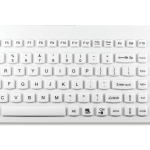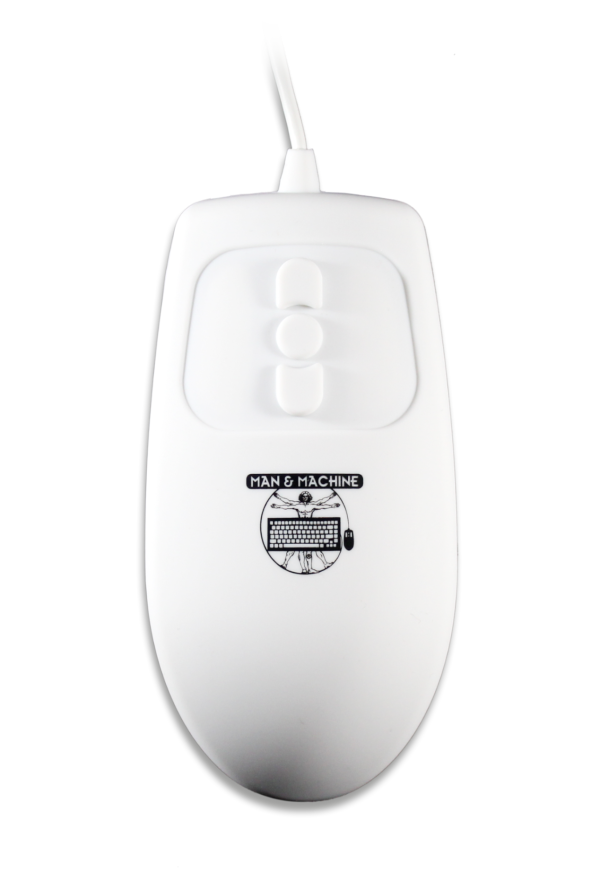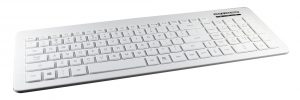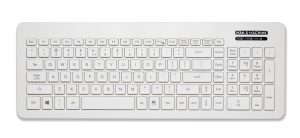EN 60601-1-2
We are frequently asked whether our products are “certified medical products” in accordance with the EN 60601-1-2 standard.
In short, the answer is that some of our products comply with this standard, while others do not. For those that do, the following statement applies:
“(The product) complies with the EMC guidelines in EN 60601-1-2:2015 (or alternatively IEC 60601-1-2:2014), both commonly referred to as the 4th edition.”
To provide a more in-depth explanation of this statement and how EN 60601-1-2 is applied at Man & Machine, Inc., we will address the following nine questions:
1. What is EN 60601-1-2?
2. Which products need to be certified according to this standard?
3. What does EN 60601-2 involve?
4. Which version of EN-60601-1-2 is the latest one?
5. Why is there a new Edition (4) of EN 60601-1-2?
6. What are the major differences between the previous Edition 3 and the current valid Edition 4 in relation to EMC tests?
7. Which Man & Machine products are subject to EN 60601-1-2?
8. Which Man & Machine products comply with the conditions for the EMC criteria in EN 60601-1-2?
9. Which statements can be made about the certification of Man & Machine products that comply with the conditions for the EMC criteria in EN 60601-1-2?
1. EN 60601-1-2 Explained
The EN series of standards known as EN 60601 defines safety requirements and ergonomic standards for medical equipment and medical systems.
These norms are divided into different partial or collateral standards:
-
- EN 60601-1 General Requirements
- EN 60601-1-1 System Standard (can only be used with EN 60601-1:1990, its content has now been included in Section 16 of EN 60601-1:2006)
- EN 60601-1-2 EMC Standard
- EN 60601-1-3 General Radiation Protection in Diagnostic X-Ray Equipment
- EN 60601-1-4 Software Standard (can only be used with EN 60601-1:1990, its content has now been included in Section 14 of EN 60601-1:2006)
- EN 60601-1-6 Usability
- EN 60601-1-8 Alarm Systems
- EN 60601-1-9 Reducing Effects on the Environment
- EN 60601-1-10 Physiologic Closed Loop Controllers
- EN 60601-1-11 Medical Equipment in a Home Health Care Environment
- EN 60601-1-12 Medical Equipment for Use in an Emergency Medical Services Environment
EN 60601-1-2:2015 (also known as IEC2 60601-1-2:2014) is a collateral standard, as indicated above, and applies to medical electrical/electronic equipment.
Its full title is:
“Medical Electrical Equipment – Part 1-2: General Requirements for Basic Safety and Essential Performance– Collateral Standard: Electromagnetic Compatibility – Requirements and Tests.”
2. Products Requiring Certification
Any product defined as a “medical product” or “medical system” according to Section 3 of the German Medical Products Act, needs to be tested and certified according to EN 60601 or one of its partial standards. Manufacturers can also certify their products according to this standard or one of its partial standards on a voluntary basis, even if their items are not defined as a medical product.
3. What does EN 60601-2 involve?
Medical electrical products have to be absolutely safe. They are not allowed to break down or malfunction if any radiation interference comes from other electrical units like mobile phones or tablets. Conversely, medical products are not allowed to negatively affect the environment through electromagnetic emissions either (such as other medical products, the phone and radio networks, computers or the electricity supply).
In essence, EN 60601-1-2 defines the requirements for electromagnetic compatibility (EMC), which is why it is often referred to it as the EMC standard. The standard defines the term electromagnetic compatibility as the “capacity of a medical device or a medical system to function satisfactorily in its electromagnetic environment without introducing any electromagnetic disturbance into this environment, which also includes other equipment.” It specifically stipulates the following:
-
- The types of electromagnetic interference that medical products have to cope with without any problems
- The amount of electromagnetic radiation medical products may emit
- How the requirements in this respect may depend on the specific environment where the unit is used and the risk emanating from the product
- The necessary requirements to measure, test and document these measurements; and how the manufacturer must mark the product, and which information must be found in the operating instructions.
4. Latest Version of EN 60601-1-2
EN 60601-1-2 Edition 4 has been in force since January 2019. It therefore replaces Edition 3, which had been mandatory since 2017. All medical electrical equipment has had to meet the new requirements for electromagnetic compatibility (EMC) since the beginning of 2019.
5. Reason for the New Edition (4) of EN 60601-1-2
The environments, where medical equipment is being used, are more complex now than ever before. Technologies are continuing to develop at a rapid pace and this makes it necessary to permanently adapt the requirements that are stipulated in standards. One of the most important new features in EN 60601-1-2 Edition 4 is the stronger focus on “intended usage environments”, for which risk management is necessary in each case, according to EN 149713. This describes the increases in requirements for professional health care, for health care at home and for “special” environments. The tougher EMC test specifications in Edition 4 are also designed to ensure resistance to interference in the relevant conditions.
6. Key Differences Between Edition 3 & Edition 4 for EMC Tests
| Test | Edition 3 | Edition 4 | |
| ESD according to EN 61000-4-2 | Contact discharge Air discharge |
± 2, 4, 6 kV ± 2, 4, 8 kV |
± 2, 4, 8 kV ± 2, 4, 8, 15 kV |
| Interference resistance against radiated fields according to EN 61000-4-3 |
Enclosures | 3 V/m, life-sustaining unit 10 V/m 80% AM at 1kHz or 2 Hz, 80 MHz to 2500 MHz |
3 V/m, home health care 10 V/m 80% AM at 1kHz or critical frequency, 80 MHz up to 2700 MHz |
| Fast transients and burst immunity according to EN 61000-4-4 |
AC mains or DC input I/O Ports |
± 2kV, 5kHz pulse repetition frequency ± 1kV, 5kHz pulse repetition frequency |
± 2kV, 100kHz pulse repetition frequency ± 1kV, 100kHz pulse repetition frequency |
7. Man & Machine Products Subject to EN 60601-1-2
No Man & Machine product is subject to mandatory certification in line with EN 60601 or EN 60601-1-2. Keyboards or computer peripheral items are not defined as medical equipment in the sense of the Medical Products Act. However, in order to provide evidence of their special suitability for use in the relevant fields (clinics, medical practices), some products have been subjected to an EMC test in line with the strict criteria of EN 60601-1-2: 2015 also known as 4th Edition.
As far as customized products are concerned, certification would only become necessary if this involved a medical product/system in line with the Medical Products Act. However, as this would be managed as an individual project, and only if certification was necessary, no general measures can be derived to cover this situation.
8. MAN & MACHINE PRODUCTS Meeting EMC Criteria in EN 60601-1-2
As outlined in Section 7, some of our models comply with the EMC requirements in line with EN 60601-1-2 Edition 4. The complete EMC reports can be requested, under a signed NDA, from your Man & Machine Account Manager at any time.
| Really Cool |  |
Mighty Mouse |  |
| Slim Cool |  |
Petite Mouse |  |
| Very Cool |   |
||
9. statements about Certification of Man & Machine Products Under EN 60601-1-2 EMC Criteria
The products are specifically not certified in line with EN 60601-1-2 (Edition 4). The reason for this is primarily based on risk management, which needs to consider all the relevant areas of medical usage. As a keyboard is part of the so-called general or basic equipment, it can be used in almost any specific environment. It is therefore almost impossible to assess or manage the risks in question (which must take place according to EN 14971) – which is not a beneficial process. In this respect, the tests performed on the keyboards according to EN 60601-1-2 Edition 4 solely relate to their EMC. The model(s) completely passed this EMC test. The products are therefore formally suitable for use in medical and medically-related environments.
This is the best possible way of stating this in English:
(The product) complies with the EMC guidelines in EN 60601-1-2:2015 (or alternatively IEC 60601-1-2:2014) both also referred to as 4th edition.
Man & Machine, Inc, 1 October 2020
- European standard. The European standards (EN) are rules that have been ratified by one of the three European committees for standardization (European Committee for Standardization or CEN, European Committee for Electrotechnical Standardization or CENELEC and the European Telecommunications Standards Institute or ETSI).
- The International Electrotechnical Commission is an international organization that establishes standards in the fields of electrotechnology and electronics. Some of its norms are jointly defined with EN standards.
- EN 14971 is the standard for “Applying Risk Management to Medical Products.” It describes a risk management process, which is designed to guarantee that the risks caused by medical products are known and managed and are acceptable in comparison to their benefits.
